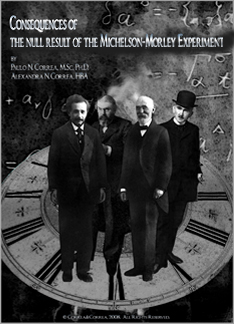![Akronos logo]](/images/akronos_wheel.jpg)
|
Akronos Publishing Concord, ON, Canada www.aetherometry.com |
![Akronos logo]](/images/akronos_wheel.jpg)
|
Akronos Publishing Concord, ON, Canada www.aetherometry.com |

Consequences of the null result of the Michelson-Morley experiment:
the demise of the stationary aether, the rise of Special Relativity,
and the heuristic concept of the photon
by Correa, Paulo N. & Correa, Alexandra N.
Published in April 2002. 46 pages.
Aetherometric Theory of Synchronicity, Vol. 1
Monograph AS3-I.1
VIEW FULL TEXT: PDF
First published in Infinite Energy #38
|
ABSTRACT
The first principle of SR posits that there is no absolute motion referenced to an unchanging frame of Space, since all translatory motion is relative to an observer at rest in its own inertial frame of reference. As the covariant complement to the contraction of length in the direction of motion is the objective dilation of time, SR is constrained to 'spatialize Time' by reducing it to a length of Space. Subsequently, once all lengths are treated as covariant intervals, the simultaneity of events is no longer invariant, nor, for that matter, is the notion of spatial coincidence. Synchronicity is considered to be an actual impossibility, and the function for a spatio-temporal continuum remains dissociated from any concept of energy, being flattened onto four-dimensional Space-Time. SR's second principle postulates that the speed of light is a constant for every inertial frame of reference, that is, is the same in all directions and for all observers, and independent of the motion of the source of light or the motion of the receiver, for as long as we are considering solely 'substantial translatory motions'. SR's position in this respect is somewhat paradoxical: one can say that it satisfies Machian relationism by positing all electromagnetically valid observers as being at rest in inertial frames of translation, their speeds being all relative and none absolute. But with the second principle, it explicitly recognizes some form of absolute velocity, an absolute speed of radiation in vacuo which is constant for all inertial frames in 'sufficient translation'. Where SR had proposed that one should conclude from the MM experiment that there is no stationary aether, and that the propagation of light is independent from the inertial frame of the observer, Einstein's photon theory proposes a new model where there is no need to take recourse to an aether in order to explain the propagation of light. The authors propose that, whereas SR was correct in positing the abolition of the stationary aether and in postulating as invariant the electromagnetic speed c, its requirements for adoption of the Lorentz transformations rely entirely upon the classical electrodynamic interpretation of the Kauffman-Bucherer-Bertozzi-type experiments. Since there are critical alternative evaluations of these experiments, this is a tenuous foundation for the abolition of synchronicity. Furthermore, the authors propose that Einstein's heuristic hypothesis be taken as factual - the result being that electromagnetic radiation becomes secondary to an energy continuum that is neither electromagnetic nor amenable to a four-dimensional reduction. It follows that the second principle of SR only applies to photon production, which is always and only a local discontinuity. It does not apply to non-electromagnetic radiation, nor, a fortiori, to the propagation of energy responsible for local photon production. |